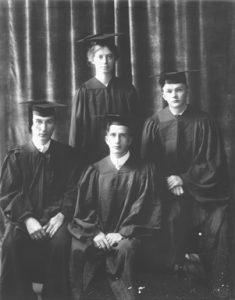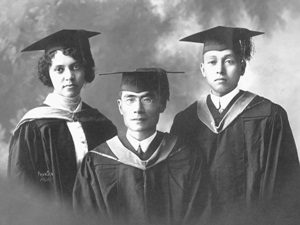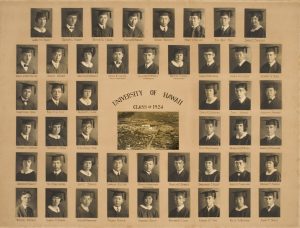Graduating Class Photographs, 1912-1934
From the first graduation from the College of Hawaiʻi in 1912 through 1934—with the possible exception of 1931—the College/University created photographs of each year’s graduating class. In the first decade, the photographs varied between group pictures and composite photographs made of individual portraits, but after 1921, all photographs are composites. The University Archives lacks original prints for two years, 1922 and 1931, however there is now a digital copy of the class photograph of 1922, complements of the Patsy Mink Ephemera Collection in the Hawaiʻi Congressional Papers Collections. (Additionally, the Ka Palapala yearbook for 1931 shows 130 graduating seniors.)

The 1914 and 1915 photos are notable for including firsts: the College’s first graduate degree in 1914 and its first African-American graduate in 1915.


The number of graduating seniors per class increases dramatically throughout the time period covered by the class photos. In 1921 eleven graduated (nine appeared in the class photograph). In the composite photograph of the Class of 1922, seventeen graduates had their pictures taken. In 1923, twenty-seven graduated. The following year saw an even greater leap in the number of graduates, to forty-seven. (This large increase is attributable to the change in the institution’s status from the College of Hawaiʻi to the University of Hawaiʻi four academic years earlier.)
The Classes of 1923 and 1924 further demonstrate the rapid growth in the size of the student body of the University of Hawaiʻi. The class of 1923 includes at least three women who later became faculty members at the University: May Gay, who taught physical education and also wrote the university song, “In Green Mānoa Valley;” Ruth Yap, who went on to Columbia University for a masters degree in education and later returned to UH to teach mathematics; and Marie Hoermann, wife of the pastor of the Lutheran Church of Honolulu, who taught German at UH.


The size of UH’s graduating classes continued to increase over the next decade, with 85 graduates in 1927, 110 in 1930, and 204 in 1934. The composite photo for 1933 had been so large it had to be divided into multiple pieces for storage purposes. The 1934 composite—likely the final graduating class photograph—is a manageable size, but it instead features individual photos so small they are nearly unrecognizable except when viewed from very close up.

